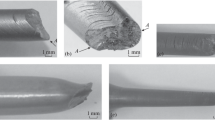Conclusions
-
1.
The results show that when the temperature is reduced from 293 to 11°K the fatigue crack growth rate in Kh60MVYu nickel alloy decreases only insignificantly and only in the near-threshold region. Under the effect of vacuum the rate decreases to a considerably greater extent and in a wider range.
-
2.
The threshold stress intensity factor Kth increases under the effect of both the medium and low temperature (11°K).
-
3.
The size of the plastic zone at the crack tip is independent of the medium and decreases with decreasing temperature.
-
4.
The size of the plastic zone at the point with the abscissa K* corresponds to 2h=3d, both for 293°K and 11°K. At this point the value m changes abruptly from m2=2 to m1=6.
Similar content being viewed by others
Literature Cited
W. A. Logsdon, “Characteristics of failure of X750 Inconel alloy in relation to the production technology and heat treatment conditions,” in: Mechanical Properties of Structural Materials at Low Temperature [in Russian], Metallurgiya, Moscow (1983), pp. 298–310.
R. P. Read, R. L. Tobler, and R. P. Mikesell, “Fracture toughness and fatigue crack growth rate in an alloy of the Fe−Ni−Cr system at 298, 76, and 4°K,” in: Mechanical Properties of Structural Materials and Low Temperatures [in Russian], Metallurgiya, Moscow (1983), pp. 321–331.
W. A. Logsdon, R. Kossowski, and G. Wells, “Effect of production technology and heat treatment on the failure characteristics of Inconel 718 alloy at low temperatures,” in: Mechanical Properties of Structural Materials at Low Temperatures [in Russian], Metallurgiya, Moscow (1983), pp. 331–345.
L. F. Yakovenko and N. M. Grinberg, “The role of the environment in low-temperature tests,” Fiz.-Khim. Mekh. Mater., No. 2, 24–26 (1977).
J. R. Rice, “Mechanics of crack tip deformation and extension by fatigue,” in: Fatigue Crack Propagation, ASTM STP, No. 415, Philadelphia (1967), pp. 247–311.
V. M. Boichuk, “MUVR and MUVK fatigue machines for low-temperature testing in vacuum,” Probl. Prochn.; No. 4, 53–55 (1971).
V. M. Boichuk, E. A. Amelin, and S. A. Kulik, “A machine for testing the strength of materials at low temperature,” Inventor's Certificate No. 510665 USSR MKI 601 No. 3118, Byull, No. 14, published 12. 8. 76.
Procedure Instruction. Strength Calculations and Tests. Methods of Mechanical Testing of Metals. Determination of Fracture Toughness (Cracking Resistance) in Cyclic Loading (in Russian], Standartov, Moscow (1982).
E. N. Aleksenko, N. M. Grinberg, and N. L. D'Yakonenko, “Propagation of fatigue cracks in flat specimens of silicon iron in air and vacuum,” Probl. Prochn., No. 1, 42–48 (1983).
V. A. Boichuk and N. M. Grinberg, “The plastic zone and growth of fatigue cracks in magnesium MA 12 alloy at room and low temperatures,” Int. J. Fat.,5, No. 2, 79–85 (1983).
O. P. Ostash, S. Ya. Yarema, V. A. Stepanenko, and A. Ya. Krasovskii, “Effect of low temperatures on the rate and microfractographic special features of fatigue crack propagation in aluminum alloys,” Fiz.-Khim. Mekh. Mater., No. 3, 26–30 (1977).
O. P. Ostash, Yu. T. Zhmur-Klimenko, K. A. Yushchenko, et al., “Effect of low temperature on the rate and microfractographic features of fatigue crack propagation in 07Kh13G20AN4 steel,” Fiz.-Khim. Mekh. Mater., No. 2, 112–113 (1981).
G. T. Hahn, R. G. Hoagland, and I. R. Rosenfield, “Local yielding attending fatigue crack growth,” Met. Trans.,3, No. 5, 1189–1202 (1972).
C. Bathias, R. M. Pelloux, “Fatigue crack propagation in martensitic and austenitic steels,” Met. Trans.,4, No. 5, 1265–1273 (1973).
L. R. Botvina and G. V. Klevtsov, “Kinetics of development of the zones of plastic deformation in fatigue failure of 20 steel,” Fiz.-Khim. Mekh. Mater., No. 1, 39–44 (1983).
F. MacClintock and G. R. Irwin, “Plasticity problems in fracture mechanics,” in: Applied Problems of Fracture Toughness [Russian translation], Mir, Moscow (1968), pp. 143–186.
G. N. Épshtein and O. A. Kaibyshev, High-Rate Deformation and Structure of Metals [in Russian], Metallurgiya, Moscow (1971).
D. Broek, Fundamentals of Fracture Mechanics [in Russian], Vysshaya Shkola, Moscow (1980).
N. M. Grinberg, “Stage II fatigue crack growth,” Int. J. Fat.,6, No. 4, 229–242 (1984).
A. Yuen, S. W. Hopkins, G. R. Leverant, and C. A. Rau, “Correlations between fracture surface appearance and fracture mechanics parameters for state II fatigue crack propagation in Ti-6A1-4V,” Met. Trans.,5, No. 8, 1833–1842 (1974).
Additional information
Physicotechnical Institute of Low Temperatures, Academy of Sciences of the Ukrainian SSR, Kharkov. E. O. Paton Electric Welding Institute, Academy of Sciences of the Ukrainian SSR, Kiev. Translated from Problemy Prochnosti, No. 5, pp. 25–31, May, 1988.
Rights and permissions
About this article
Cite this article
Aleksenko, E.N., Grinberg, N.M. & Yushchenko, K.A. Fatigue crack growth in KhN60MVYu nickel alloy at temperatures of 293 and 11°K. Strength Mater 20, 590–596 (1988). https://doi.org/10.1007/BF01528545
Received:
Issue Date:
DOI: https://doi.org/10.1007/BF01528545




